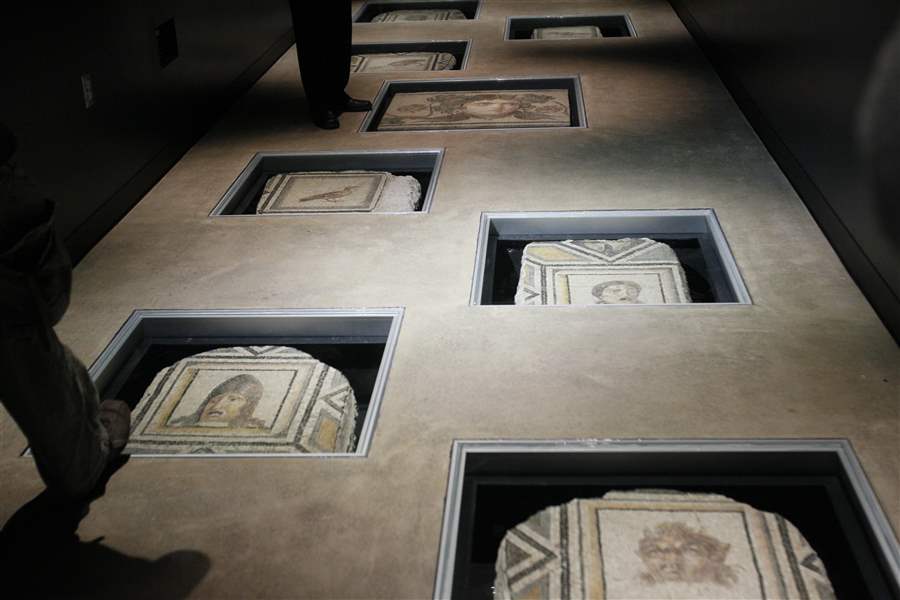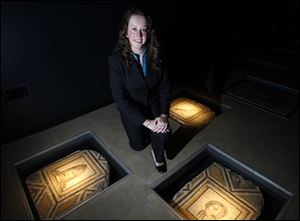
Origin of ancient mosaics at BGSU suspect
Pieces feared looted from Turkish town
2/7/2012
Made with tiny pieces of chiseled stone and glass to depict birds and faces, the 12 mosaics at the Wolfe Center for the Arts at BGSU were first believed to be from authorized excavations in Antioch, Turkey, overseen by Princeton University.
The Blade
Buy This Image

Dr. Stephanie Langin-Hooper, Assistant Professor of Ancient Art History, kneels near ancient mosaics at the Wolfe Center at Bowling Green State University, Tuesday.
BOWLING GREEN — BOWLING GREEN — A dozen mosaics from ancient Turkey that recently received a new, dramatic home at Bowling Green State University may be looted bounty.
Dating to the second or third century, the mosaics were restored and installed in the floor of the Wolfe Center for the Arts, which opened in December. They’re lit and covered with thick protective glass.
Made with tiny pieces of chiseled stone and glass to depict birds and faces, the mosaics at first were believed to have been from authorized excavations overseen by Princeton University in Antioch, Turkey, that were carefully photographed, named, and catalogued. Eleven measure 12 inches by 12 inches, but one is 2 feet by 3 feet.
They were purchased for $35,000 in 1965 at the suggestion of former art faculty member Hugh Broadley with the blessing of then-BGSU president William Jerome. Both men are deceased. Letters settling details for the purchase 47 years ago indicate they were from Antioch, Turkey. There’s apparently no information, however, about why such an unusual purchase was made for BGSU nor how it was paid for.
A new faculty member planning to write a paper about the works first questioned their origin several weeks ago.
Stephanie Langin-Hooper, assistant professor of ancient art history, found disturbingly little paperwork about the purchase. “I became a little concerned. Some of the details and information was not as much as I was expecting,” Ms. Langin-Hooper said.
Art objects usually are accompanied by papers authenticating their history and pedigree. She found just a few letters setting out terms of the purchase from Peter Marks, a gallery owner in New York.

Made with tiny pieces of chiseled stone and glass to depict birds and faces, the 12 mosaics at the Wolfe Center for the Arts at BGSU were first believed to be from authorized excavations in Antioch, Turkey, overseen by Princeton University.
Ms. Langin-Hooper contacted an expert in Antioch mosaics, Rebecca Molholt of Brown University, and the two combed through images of more than 300 mosaics that were removed from homes in that city.
“We couldn’t find them in the catalog,” said Ms. Langin-Hooper, who was hired at BGSU in August.
Ms. Malholt questioned whether the mosaics may have originated in Zeugma, another Turkish town, where unauthorized excavations occurred in the 1960s. She compared images of the BGSU mosaics to photos from homes in Zeugma and found a potential match with floor panels from a home that had similar geometric patterns, sizes, and colors. Color, size, and pattern were selected by Roman homeowners, Ms. Langin-Hooper said.
Romans ruled the Mediterranean at the time, and Roman administrators and business people oversaw matters in many countries.
The Zeugma site has since been flooded to become a reservoir, but ancient artifacts were removed and are in a nearby museum, she said.
“We’re hoping to continue the research,” she said, noting that Ms. Malholt is contacting researchers in Turkey.
BGSU has contacted the FBI and is awaiting instructions about how to proceed, said Dave Kielmeyer, a university spokesman. He said it’s too early to say whether the mosaics will be returned. The university does not purchase ancient art, he said, adding that a value has not been set for the pieces.
After the mosaics were received by BGSU they were stored until 1979, when they were placed outside a small gallery in the McFall administration building.
Mary Wolfe, a former BGSU art faculty member, led the move to have them displayed in the new center, which was supported financially by her and her husband, Fritz Wolfe.
Mrs. Wolfe could not be reached for comment Tuesday.
BGSU president Mary Ellen Mazey said the university will take whatever steps are necessary to ensure that the mosaics are handled properly.
“They have been housed at the university for nearly half our history; of course we will do the right thing. As an institution of higher learning, we have relied on the expertise of scholars both at the time of acquisition and now, as we study the origins of the mosaics going forward.”
The Toledo Museum of Art experienced a similar situation last year when it had to send a statue back to a German museum after it was determined that the piece had been stolen during World War II from the Dresden museum.
Contact Tahree Lane at: tlane@theblade.com, or 419-724-6075.